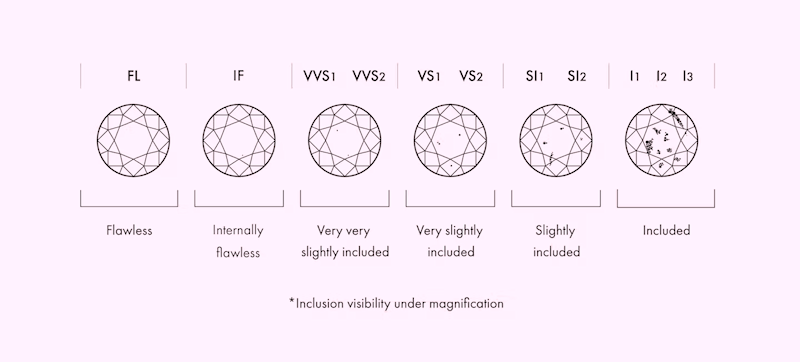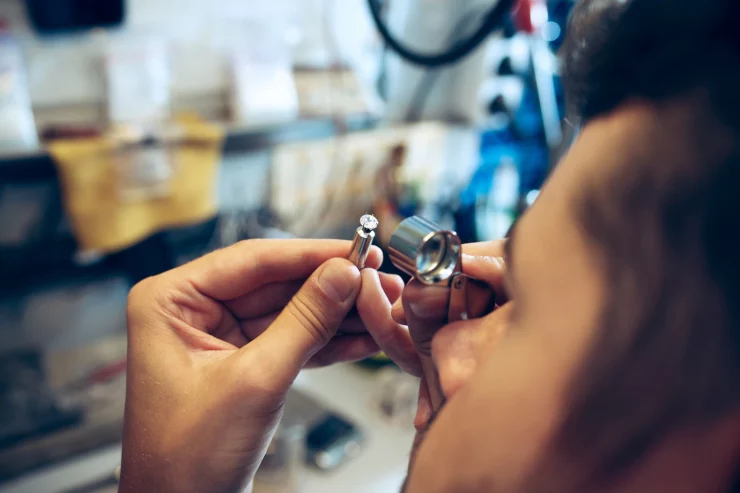
VS1 Diamonds Are Quite Rare, And High Quality
This clarity is a grading scale used by gemologists to determine the quality and clarity of a diamond. The scale ranges from FL (flawless) and Internally Flawless to I3 (included). VS1 falls into the “very slightly included” category, which means that the diamond has small inclusions that are difficult to see with the naked eye.
In terms of diamond grading, VS1 clarity is considered to be very high quality. The inclusions present in a VS1 clarity diamond are typically only visible under 10x magnification, making them almost impossible to detect without specialized equipment. These inclusions are typically small and do not affect the overall appearance or brilliance of the diamond.
The Lack Of Inclusions Makes Them Shine Better Than Lower Grade Clarities
VS1 clarity diamonds are also known for their exceptional clarity and sparkle. Because the inclusions are so small and difficult to see, they do not interfere with the light passing through the diamond, which means that VS1 clarity diamonds are able to retain their sparkling brilliance. This makes them a popular choice for engagement rings, as they offer a high level of clarity and sparkle without the need for extensive and costly cutting and polishing.
A Good Balance Between Price And Value
In general, VS1 clarity diamonds are considered to be a good balance between quality and value. They offer a high level of clarity and sparkle without the need for extensive cutting and polishing, and are an affordable option for those looking for a beautiful and sparkling diamond.
Below is an example of “VS1 Clarity”

VS1 When Compared To VVS2 and VS2 Clarity
The primary distinction between Very Slightly Included 1 and Very Slightly Included 2 diamonds is the size and clarity of their inclusions. VS1 types have inclusions that are relatively small and hard to see under 10x magnification, while VS2 ones have inclusions that are a bit larger and more discernible under magnification. As a result, VS1 diamonds are generally perceived as higher quality and value than their VS2 counterparts.
Comparing VS1 to VVS2 diamonds, the main difference is the quantity and clarity of their inclusions. VVS2 types have minimal inclusions that are challenging to see under 10x magnification, whereas VS1 has a few more inclusions discernible under the same magnification. Consequently, VVS2 diamonds are deemed higher in quality and value than Very Slightly Included 1.
In summary, while the core difference between VS1 and VS2 diamonds is the size and clarity of inclusions, the distinction between VS1 and VVS2 is the quantity and visibility of their inclusions. These diamonds are of superior quality and value than VS2, but not as pristine or valuable as VVS2.

Alternative Diamond Choices
In the world of gemology, diamonds, particularly the ones mined from the Earth, have long been the crowning jewel, a testament to luxury, commitment, and timeless elegance. However, as the decades have unfolded and technology has progressed, alternative choices to natural diamonds have burgeoned, offering consumers a wider array of options and considerations. One of the most significant advancements in this sphere is the emergence of lab-grown diamonds. These diamonds are not mere simulants or substitutes; they share the exact physical, chemical, and optical properties as their mined counterparts. Cultivated under controlled laboratory conditions, lab-grown diamonds are developed using advanced technological processes that replicate the conditions under which diamonds naturally form.
From a clarity and value perspective, lab-grown diamonds often present a compelling case. Because they are produced in a controlled environment, it’s sometimes possible to achieve better clarity grades with fewer inclusions, as compared to natural diamonds which are formed over millions of years with various environmental interferences. Moreover, lab-grown diamonds generally come at a fraction of the price of natural diamonds, offering consumers similar or even superior quality at a reduced cost. But it’s not just lab-grown diamonds that serve as alternatives. Other gemstones, both precious and semi-precious, have found their place in jewelry pieces that were once dominated by diamonds. Stones like sapphires, rubies, emeralds, and moissanites offer varied palettes of color, brilliance, and character, allowing individuals to choose something that resonates more with their personal tastes, beliefs, or budgetary constraints. While these alternatives may not always match the unparalleled hardness and sparkle of a diamond, they bring forth unique attributes and histories that can be just as enchanting.

Global Sources of VS1 Diamonds
The intricate journey of a VS1 diamond, from its genesis deep within the Earth’s mantle to the sparkling ornament in a jewelry store, is a tale shaped by geology, geography, and human endeavor. The global sourcing of these high-clarity diamonds is an interwoven tapestry of locations, each with its unique geological fingerprint. Historically, India was the epicenter of diamond mining, but as time went on and resources dwindled, the baton was passed to other parts of the world. Today, the vast landscapes of Russia, particularly in the Yakutia region and the Arkhangelsk region, and Botswana are leading contributors to the world’s diamond supply. Botswana, with its Orapa and Jwaneng mines, stands as one of the largest diamond producers by value.
Moreover, Canada, a relatively newer entrant in the diamond mining arena, has rapidly ascended the ranks with mines such as Ekati and Diavik, particularly known for their high-quality diamonds. African countries like South Africa, Namibia, and Angola too have rich diamond deposits and play pivotal roles in the global supply chain. When specifically considering VS1 clarity diamonds, while they can be found in various mining locations globally, their prevalence is subject to the geological conditions and processes unique to each location. It’s important to note that beyond the geographical sourcing, the journey of a diamond, especially in today’s conscious consumer landscape, is also marked by ethical considerations, certifications, and traceability to ensure that the stones are conflict-free and sourced responsibly.
VS1 Diamonds as an Investment
Investing in diamonds, or any gemstone for that matter, is a nuanced endeavor, often markedly different from traditional investment avenues. When examining VS1 diamonds as an investment vehicle, several facets come into play. VS1 diamonds, as already outlined, fall in the high-quality spectrum of clarity grades. Their inclusions, minute and difficult to discern, lend them a brilliance and purity that’s highly sought after. Such clarity not only ensures aesthetic appeal but also contributes to the diamond’s value retention and appreciation potential.
Compared to lower clarity grades like SI1 or SI2, a VS1 diamond generally has a higher entry price point, but it also offers a better resale potential given its quality and the desirability factor attached to it. On the other hand, when juxtaposed against higher clarity grades like VVS1 or VVS2, VS1 diamonds present a more affordable and value-for-money proposition. They deliver almost comparable brilliance and appearance at a fraction of the price, making them an attractive choice for investors seeking a balance between quality and cost. It’s imperative, however, for potential investors to understand that like all investments, diamonds too have their cycles, influenced by global economic conditions, supply-demand dynamics, and consumer trends. A well-informed decision should be based on thorough research, consultation with gemologists and industry experts, and an understanding that diamonds, beyond their investment potential, are also symbols of legacy, emotion, and timeless beauty.
5 Great Things About VS1 Diamonds:
- VS1 diamonds are high quality. VS1 diamonds are considered to be of high quality in terms of clarity, with inclusions that are relatively small and difficult to see under 10x magnification. As a result, these diamonds have a high level of sparkle and brilliance.
- These diamonds are affordable. Compared to VVS1 or VVS2 diamonds, which are considered to be higher quality in terms of clarity, these diamonds are typically more affordable. This means that they can provide a high level of quality and value at a lower price point.
- VS1 diamonds have a good resale value. Because they are considered to be of high quality, they often have a good resale value. This means that if you purchase a VS1 diamond, you can expect to get a good return on your investment if you decide to sell it in the future.
- These diamonds are durable. Inclusions and blemishes in diamonds can act as points of weakness, making the diamond more susceptible to chipping or breaking. Because these diamonds have relatively few inclusions, they are generally more durable and less likely to be damaged than lower quality diamonds.
- Diamonds of this quality are aesthetically pleasing. Because they have a high level of clarity, VS1 diamonds have a clean, pure appearance that is highly desirable to many people. This makes them pleasing to the eye and can enhance the overall beauty of a piece of jewelry.